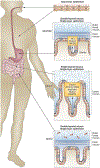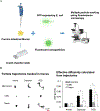Native gastrointestinal mucus: Critical features and techniques for studying interactions with drugs, drug carriers, and bacteria
- PMID: 37329985
- PMCID: PMC11184232
- DOI: 10.1016/j.addr.2023.114966
Native gastrointestinal mucus: Critical features and techniques for studying interactions with drugs, drug carriers, and bacteria
Abstract
Gastrointestinal mucus plays essential roles in modulating interactions between intestinal lumen contents, including orally delivered drug carriers and the gut microbiome, and underlying epithelial and immune tissues and cells. This review is focused on the properties of and methods for studying native gastrointestinal mucus and its interactions with intestinal lumen contents, including drug delivery systems, drugs, and bacteria. The properties of gastrointestinal mucus important to consider in its analysis are first presented, followed by a discussion of different experimental setups used to study gastrointestinal mucus. Applications of native intestinal mucus are then described, including experimental methods used to study mucus as a barrier to drug delivery and interactions with intestinal lumen contents that impact barrier properties. Given the significance of the microbiota in health and disease, its impact on drug delivery and drug metabolism, and the use of probiotics and microbe-based delivery systems, analysis of interactions of bacteria with native intestinal mucus is then reviewed. Specifically, bacteria adhesion to, motility within, and degradation of mucus is discussed. Literature noted is focused largely on applications of native intestinal mucus models as opposed to isolated mucins or reconstituted mucin gels.
Keywords: Bacteria-mucin interactions; Fluorescence recovery after photobleaching; Mucosal drug delivery; Mucus barrier properties; Mucus composition; Mucus structure; Multiple particle tracking; Native intestinal mucus.
Copyright © 2023. Published by Elsevier B.V.
Conflict of interest statement
Declaration of Competing Interest The authors declare that they have no known competing financial interests or personal relationships that could have appeared to influence the work reported in this paper.
Figures




Similar articles
-
Development and Functional Properties of Intestinal Mucus Layer in Poultry.Front Immunol. 2021 Oct 4;12:745849. doi: 10.3389/fimmu.2021.745849. eCollection 2021. Front Immunol. 2021. PMID: 34671361 Free PMC article. Review.
-
Development of a Caco-2-based intestinal mucosal model to study intestinal barrier properties and bacteria-mucus interactions.Gut Microbes. 2025 Dec;17(1):2434685. doi: 10.1080/19490976.2024.2434685. Epub 2024 Dec 23. Gut Microbes. 2025. PMID: 39714032 Free PMC article.
-
Human mesofluidic intestinal model for studying transport of drug carriers and bacteria through a live mucosal barrier.Lab Chip. 2025 Jun 10;25(12):2990-3004. doi: 10.1039/d4lc00774c. Lab Chip. 2025. PMID: 40392585 Free PMC article.
-
Microbial adhesins to gastrointestinal mucus.Trends Microbiol. 2012 Jan;20(1):30-9. doi: 10.1016/j.tim.2011.10.001. Epub 2011 Nov 14. Trends Microbiol. 2012. PMID: 22088901 Review.
-
Delivery of a mucin domain enriched in cysteine residues strengthens the intestinal mucous barrier.Sci Rep. 2015 May 14;5:9577. doi: 10.1038/srep09577. Sci Rep. 2015. PMID: 25974250 Free PMC article.
Cited by
-
Assessment of polymeric mucin-drug interactions.PLoS One. 2024 Jun 27;19(6):e0306058. doi: 10.1371/journal.pone.0306058. eCollection 2024. PLoS One. 2024. PMID: 38935605 Free PMC article.
-
Cyclodextrin-mediated enhancement of gastrointestinal drug delivery: unveiling mucoadhesive and mucopenetrating synergy.Drug Deliv Transl Res. 2025 Oct;15(10):3753-3767. doi: 10.1007/s13346-025-01832-w. Epub 2025 Mar 20. Drug Deliv Transl Res. 2025. PMID: 40113660 Free PMC article.
-
A Strategic Blend of Stabilizing Polymers to Control Particle Surface Charge for Enhanced Mucus Transport and Cell Binding.bioRxiv [Preprint]. 2024 Sep 19:2024.09.17.613453. doi: 10.1101/2024.09.17.613453. bioRxiv. 2024. PMID: 39345382 Free PMC article. Preprint.
-
Mucoadhesive-to-Mucopenetrating Nanoparticles for Mucosal Drug Delivery: A Mini Review.Int J Nanomedicine. 2025 Feb 20;20:2241-2252. doi: 10.2147/IJN.S505427. eCollection 2025. Int J Nanomedicine. 2025. PMID: 39995958 Free PMC article. Review.
-
Wheat germ agglutinin modified mixed micelles overcome the dual barrier of mucus/enterocytes for effective oral absorption of shikonin and gefitinib.Drug Deliv Transl Res. 2025 Jan;15(1):325-342. doi: 10.1007/s13346-024-01602-0. Epub 2024 Apr 24. Drug Deliv Transl Res. 2025. PMID: 38656402
References
-
- Crater JS, Carrier RL, Barrier properties of gastrointestinal mucus to nanoparticle transport, Macromolecular bioscience, 10 (2010) 1473–1483. - PubMed
Publication types
MeSH terms
Substances
Grants and funding
LinkOut - more resources
Full Text Sources

